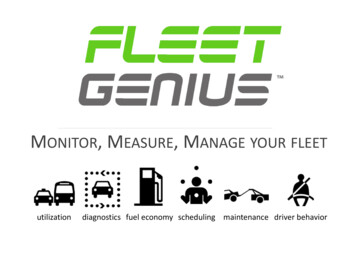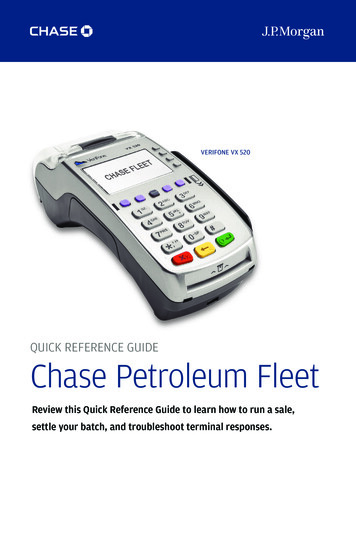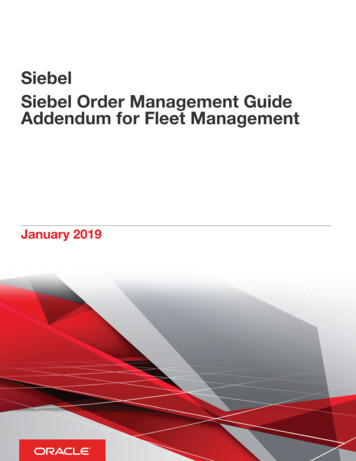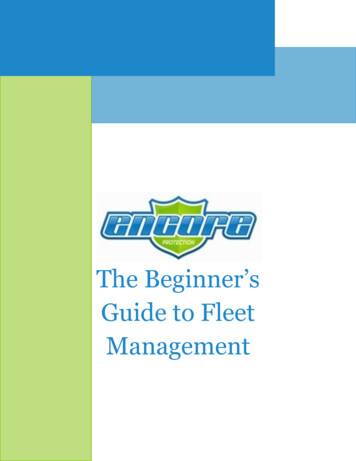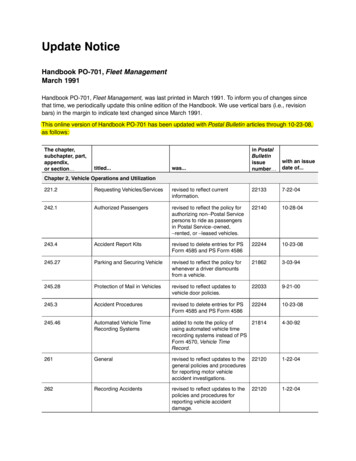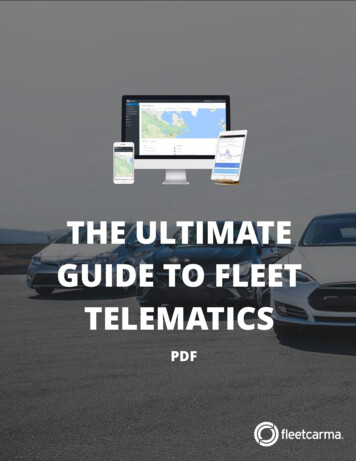
Transcription
THE ULTIMATEGUIDE TO FLEETTELEMATICSPDF
Who This Guide Is ForThe Telematics Curious. You do not currently have a telematics solution,and are wondering if it is something your organization should invest in. You wantto learn what the main types of telematics are and what they deliver.The Telematics Update. You have been using telematics for a while, butare looking for an update on the state of the industry. You want to learn what isnew and what are some of the key features now available.The Telematics Disappointed.You have a telematics solution, butaren’t getting what you expected. You want to learn what the market norms are,and if your vendor is under-performing.The Telematics RFP Writer. You are scoping an RFP for telematics andwant to understand what options are available and what features are most valuedby fleets.
Table of Contents1.What is Telematics?2.Who Uses Telematics?3.Fleet Telematics: The Nuts and Bolts Level 1: GPS Tracking Level 2: On-board Diagnostics Level 3: Enhanced Signals Level 4: Enhanced Signals Electric Vehicle Support4.Popular Telematics Providers5.Addressing Security Concerns6.Driver Privacy Issues7.The Future of Telematics8.Checklist for Fleets Considering Telematics
IntroductionA fleet of vehicles plays a critical role in the daily operations of many organizations. If a vehicleisn’t available when someone needs it, they are unable to do their job. At the same time,operating a fleet involves significant costs. Given the importance and the costs involved,organizations hand the reigns to a given person: the fleet manager.Fleet managers are responsible for keeping costs low while delivering high availability of a safeand reliable fleet of vehicles. The result is that fleet managers need to be equally fluent in thefinance, operations, and technical aspects of automotive technology.Operationally, this means knowing what is required of your fleet, understanding which vehiclesare best suited for which applications, tracking and predicting the Total Cost of Ownership (TCO)of those vehicles, knowing when the vehicles need to be serviced, training drivers for safe andeconomical driving, and being aware of what is going on with your fleet at any given moment.And with so many moving parts, managing a fleet can look something like this This is where telematics comes into play. Designed to be a fleet manager’s best friend, fleettelematics aims to help fleets plan for the future, ensure productive day-to-day operation, andreact to unforeseen events in real-time.Backed by data, it helps fleet managers automate important functions, and allows them to focusmore on the bigger picture items.
What is Telematics?While telematics is a combination of the words telecommunications (the exchange of informationover distances) and informatics (the science of processing data), we propose a more nounTelematics tell people how welltheir machines are working.In other words, telematics is a system that collects data to provide you with actionableinformation and guidance. The best telematics systems understand that its job is to save – notconsume – the time of the fleet management team.
Who Uses Telematics In Their FleetsGeneral FleetsUtility CompaniesGovernments andMunicipalitiesTaxi ring Services
Fleet Telematics: The Nuts and BoltsIt begins with either a physical device or piece of software inside the vehicle. It can make its wayinto the vehicle straight from the original equipment manufacturer (OEM) or from a third-partyprovider.OEM telematics can make sense when your fleet is mostly comprised of one vehiclemanufacturer, and you are completely satisfied with their telematics offering. In any otherscenario, using a third-party provider typically makes more sense.A third-party solution allows you to deploy across all your vehicle makes/models, and doesn’trestrict you to one manufacturer moving forward. They are also generally better designed for fleetapplications, allow you to tailor your solution, and are quicker to see features added to thesystem.
Fleet Telematics: The Nuts and BoltsFor the purpose of this guide, we’ll be digging deeper into the third-party telematics systems.There is no one-size-fits-all solution.All telematics systems were not made the same. Consider these potential use-cases: GPS tracking to provide not only location information but also insight on vehicle speedand mileage covered Communications tech to keep driver and dispatch on the same page Sensors to monitor vehicle performance, driving behavior, and self-diagnostics formaintenance purposes Cameras to relay information on road conditions EV charging data to understand infrastructure requirementsThus there are different types of telematics systems designed for the unique purposes that theyserve.Let’s take a look at the different levels.
Level 1: GPS TrackingThe first level involves only the use of GPS tracking. “Only” GPS tracking can still deliver a greatdeal of data though, giving users access to features such as: Map location Vehicle speed Vehicle idle time Geofences (for real-time location-based alerts) Fuel economy when fuel card integration is availableThis is accomplished by installing a GPS tracking device, or tapping in to the vehicle’s own GPSconnection. The data is then transmitted to an online portal where it can be analyzed andprocessed for reporting.Even with the limited number of features GPS tracking provides, the benefits are considerable.Fleets are able to know where their vehicles are in real-time. They can improve customer servicewith better dispatching, enabling near-by drivers to show up to client emergencies. They canimprove productivity by optimizing routes. They can improve fleet efficiency by reducing idleevents and providing feedback to better train drivers.
Level 1: GPS TrackingFleets can also use the hard acceleration/braking & speeding metrics to increase driver safety,consequently bringing down insurance costs. Lastly, getting the vehicle GPS data can helpautomate compliance reporting when meeting with company executives.The downside of GPS tracking is that you’re only able to get high-level data. You’re not able to getinformation directly from the vehicle, such as diagnostic reports or accurate fuel efficiency data.You also can not access any important electric vehicle-specific data.
Level 1: GPS Tracking OverviewBenefitsReal-time location of vehicles.Better customer service. With precise locations of your fleet vehicles, dispatchers can communicate withcustomers to deliver accurate time estimates.Greater efficiency. Whether you operate gasoline vehicles, hybrids, or EVs, improving economy is aconstant struggle. GPS tracking helps with:Driver feedback to better train drivers & increase fuel efficiencyCutting down operating expenses/labor costsGeofences for real-time alerts and to help analyze activityReporting to identify areas of improvementBetter productivity. Optimized routes make drivers more productive and happier on the job.Safer drivers. Driver feedback not only reduces fuel efficiency, but also decreases the odds of getting intoan accident.Reduced insurance.Can begin to automate compliance reporting.DrawbacksUnable to get vehicle-specific data. Limited to what GPS tracking data can provide.Only provides high-level insight, and is not a good source for granular, highly accurate data.Use CasesGeneral fleets hoping to track their vehicles and assets.Fleets looking to get started with telematics.Real-time location of vehicles.
Level 2: On-Board DiagnosticsWhile GPS tracking is a good starting point for fleets looking to adopt telematics, on-boarddiagnostics (OBD) take it up another level. Anyone familiar with the “check engine” alert on avehicle display understands what it is capable of. All vehicles from the 1996 model year onwardhave an OBD-II port available.Plugging a device into the OBD-II port allows users to retrieve basic vehicle data. With thisinformation you’re able to calculate fuel economy, record accurate trip logs, view enginetemperature, and tap into the stream of Diagnostic Trouble Codes (DTCs) – among other options.These features are useful for accurate reporting and providing real-time driver feedback, but alsoenable you to run a better maintenance program. By receiving DTC alerts from the vehicle, you’reable to address maintenance-related issues as they arise.The downside of OBD-based telemetry is that the type of information it provides is still somewhatlimited. On-board diagnostics became standardized after a ruling by the California Air ResourcesBoard and EPA, and its sole mandate was that you need to be able to retrieve emissions datafrom any North American vehicle. If you’re looking to retrieve anything more than emissionsrelated data, you’ll need a more advanced solution.
Level 2: On-Board DiagnosticsOverviewBenefitsEverything from Level 1 telematics (if the device has GPS tracking built in).Better fleet maintenance. With DTC alerts, fleet owners can service vehicles faster and maintain them inbetter condition.Real-time driver feedback. Information from the vehicle can quickly be relayed to an app.Provides more information than GPS tracking, and with better accuracy.DrawbacksStill lacks some important data, such as odometer readings and seat belt status.Not compatible with plug-in vehicles. Not being able to support all vehicles means there could be holes inyour fleet operation down the road.Use CasesFleets looking for more than just GPS data.Fleets who are looking to improve their maintenance program.Fleets who don’t intend on adopting EVs in the near future.
Level 3: Enhanced SignalsLevel 3 Enhanced Signal telematics goes beyond what GPS tracking and on-board diagnostics canaccomplish by bringing a wider range of data into the equation.By tapping into enhanced signals from the CAN bus, you’re able to retrieve data that isn’t madereadily available through the OBD port. You’re able to access information such as: True odometer readings Seat belt status Individual tire pressures Power take-off status (for bucket trucks) Auxiliary loads (particularly useful for EVs)The big one here is the true odometer readings. Having this information allows you to schedulevehicle maintenance based on the mileage they’ve traveled, without needing your drivers torecord the information themselves.Monitoring seat belt use helps enforce that your drivers are as safe as possible in the case of anaccident. Insight into individual tire pressures can help prevent accidents due to blown tires, butalso improves the vehicle’s efficiency by having them inflated to optimal levels.
Level 3: Enhanced SignalsMuch like the “Internet of Things,” Level 3 telematics is still largely undefined. Since you’re able totap into a wide array of data, fleet managers are able to pick and choose what they’d like from thevehicle as opposed to being restricted by a limited set of features.The challenge up to this point has been that different vehicles can transmit different signals. Notonly do telematics providers need to build hardware that is capable of reading these signals, theyneed to have the engineering team to program the hardware to actually do so.
Level 3: Enhanced Signals OverviewBenefitsEverything from Level 1 and Level 2 telematics.Better preventative maintenance scheduling.A clear picture of each vehicle’s mileage and condition.Enhanced safety features.The potential to tailor solutions to your data requirements.DrawbacksDoes not support electric vehicles.Use CasesFleets looking for an advanced telematics solutionFleets who are looking to optimize their maintenance program.Fleets who don’t intend on adopting EVs in the near future.
Level 4: Enhanced Signals EVSupportWith the number of available plug-in vehicle models growing by the month, fleet managers havebegun seeking comprehensive solutions to accommodate the segment.At the highest level, a telematics system with EV support is really just an extended form of Level 3enhanced signal telematics. EVs pose new challenges though, and the level of complexity tosupport them goes far beyond just pulling another signal from the vehicle.Telematics providers need to decode each electric vehicle model, and provide a new way topresent the information (such as energy consumption, state-of-charge, or battery health) in theback-end.
Level 4: Enhanced Signals EVSupportThe benefits of having a telematics system for your EVs are substantial. Predictive analytics canhelp you choose the right electric vehicles for your fleet, based on your specific duty cycles.Monitoring the vehicles can help increase how much you utilize them (reaping the cost savings),optimize charging behavior, help you understand where charging stations might be beneficial,and automate emissions reporting.Taking advantage of integrated smart charging technology can also help reduce demand chargesand shift your charging to off-peak hours.Especially with the first generation of electric vehicles running on ranges of 100 miles or less, theyrequire careful management to ensure a positive experience. Even with longer range secondgeneration electric vehicles, EV telematics will help ensure you’re maximizing their ROI.
Level 4: Enhanced Signals EVSupport OverviewBenefitsEverything from Level 1, Level 2, and Level 3 telematics.Electric Vehicle MonitoringIncrease utilization of EVs in your fleetOptimize chargingPlan out your EV charging infrastructureMaximize the EV fraction for plug-inhybridsMonitor battery healthAutomate plug-in compliance reportingHome-charging reimbursement foremployeesEV Suitability AnalysisUnderstand where EVs are best suitedDe-risk EV adoptionRight-size your fleetSmart ChargingReduce demand charges and shift charging to off-peak hoursAutomate charge scheduleIn the case of utilities, deploy residential demand-response programsDrawbacksThere may be a slight learning curve for users when interpreting electric vehicle metrics.Drivers and management may need to adapt to the new technology.Use CasesFleets looking to adopt or purchase more electric vehicles.Utilities looking to monitor their fleet, encourage EV adoption among customers, or run a residentialsmart charging program.Electric taxi fleets hoping to maximize ROI through better dispatching.Researchers looking for a plug-and-play system to retrieve EV data.
Popular Telematics ProvidersWe’ve created a chart to list a few of the popular telematics providers. The chart does notnecessarily represent that one is better than the other, but rather indicates the level of telematicsthat their solution provides.Popular Telematics ProvidersFleetMaticsWex TelematicsNetworkfleetGPS InsightFleetCompleteGeotabZonar SystemsTelogisFleetCarma012Level of Telematics34
Get the future-proofedtelematics platform.As you may have learned from this guide so far, not alltelematics platforms are created equal.If you are simply looking for basic GPS tracking, thereare plenty of low-cost options available to you.On the flip side, if you are looking for Level 4 telematicsthat can support all your current and future vehicles,provide rich vehicle data, optimize your maintenanceprogram, and improve your fleet’s efficiency, FleetCarmamight make for a great option.If you’re interested in scheduling a demo, simply clickthe button below to start the dialogue.REQUEST A DEMO
Addressing Security ConcernsAs with any connected technology, transferring data to and from devices opens up the possibilityof information being exploited. These concerns became heightened when the FBI released apublic service announcement in March 2016 about the potential to hack third-party devicesattached to diagnostics ports.To help mitigate these risks, it’s important to establish standardized employee guidelines andwork with a telematics provider who places an emphasis on data protection. Top telematicsproviders will feature: Encrypted data streams Secure transfer of information from the vehicle to the network (and vice versa) Hardening of devicesSome providers will also feature the ability to turn off GPS data where it is especially sensitive,such as police or special forces fleets.For any level of vehicle telematics to work for an organization, security needs to be an establishedcomponent of the technology, and fleet managers should do their due diligence while exploringoptions on the market.
Driver Privacy IssuesAlso common with connected technology is the concern of having too much private informationbecome readily available. Drivers and employees may begin wondering if their movement is beingtracked by a Big Brother figure.The situation may be even trickier when drivers use company vehicles during off-hours forpersonal trips. Similar to police fleets, turning off GPS tracking for personal trips may also be anoption.Generally, drivers feel more comfortable and “buy in” to the concept of telematics when fleetowners: Provide full details of the tracking software being used, including what information isbeing recorded Offer incentives for improved driving habitsActive participation by employees is a must when adopting a new telematics solution. In order tomaximize ROI, there needs to be an open communication channel and everyone needs to be onthe same page.
The Future of Fleet TelematicsWith today’s vehicles becoming more and more sophisticated, it opens up the realm of what ispossible using telematics.Cameras, sensors and more advanced GPS have led to the self-driving car. While early semiautonomous driving systems have been far from perfect, many see fully autonomous driving asthe way of the future.Imagine the role telematics will play when vehicles are able to communicate with each other andoperate themselves. Concerns about driver workloads and scheduling may give way to wirelesscharging “self-driving-only” lanes on the highway.The human element will of course always remain prominent, but autonomous cars paired withadvanced telematics has the potential to drastically reduce operating costs, increase hours ofservice, and automate mundane tasks.
Checklist for Fleets ConsideringTelematicsWith an idea of the options available and the concerns you must address within your company ororganization, one of the above telematics solutions may look like the right choice. Before you signon, run through this checklist to make sure you are covering all the bases.Are organizational weaknesses addressed?Taking on a new telematics solution is like making a major hire – you want to be sure it’ll improvethe most prominent weaknesses within your organization. If shoddy fuel economy and lacklusterdriving skills are plaguing your fleet, you’ll need more than just the basic level of telematics.Is the future of your fleet considered?With government emissions caps being mandated and economy standards rising, the future offleets will require much greener driving systems. As you and your team ponder the righttelematics solution, consider how it will support your future vehicles. Odds are electric vehiclesare on every fleet’s horizon, so plan appropriately.Can employees handle the shift?Since most telematics platforms involve minimal driver participation, you should not have toworry about implementing technology and setting aside time for training. However, theinformation may prompt changes in driving style and the way cars are monitored. Make sure yourteam is ready to make the adjustments.Will security be an issue?The mere suggestion of a data breach or some type of network insecurity can scare stakeholdersaway. Make sure you have everything in order when it comes to data streaming and encryption.
Checklist for Fleets ConsideringTelematicsWhat other changes will come with a telematics upgrade?If an EV telematics solution makes it obvious you need better charging equipment, are you readyto allocate resources to that project? Other findings may lead you to selling off older fleet cars andmoving into more economical choices. The reports can shine a light on several inefficiencies inyour business, so be prepared for changes in other areas.Can your company afford it? Or afford not to?What separates fleet owners from the average car consumer is the consideration of the full lifecycle cost of ownership. When you hear a proposal for a telematics solution, you should have anidea what it could save you in operating costs so you can justify the initial expense. You might seea fine line between affording the solution now and not affording to run old fleet vehicles in thecoming years.Is driver safety provided for without fleet telematics?Telematics’ enhanced safety features offer fleet managers peace of mind when sending driversout into service, and insurance premiums can drop as a result. Before deciding against a solution,think about what it will mean for your drivers’ safety and your insurance costs.
Was this guide totelematics helpful?Hopefully this guide provided you with anunderstanding of what fleet telematics is, how varioussolutions can greatly differ, and what to look out for.If you have any lingering questions, we’d love to helpanswer them for you.Simply contact us using the button below and we’ll getback to you within a few hours.Thanks for reading!CONTACT US
Read the full post:The Ultimate Guide to Fleet TelematicsThank you!
Enjoy this resource?Share it with your friends and colleagues! Check out our other free resourceswww.fleetcarma.com
organizations hand the reigns to a given person: the fleet manager. Fleet managers are responsible for keeping costs low while delivering high availability of a safe and reliable fleet of vehicles. The result is that fleet managers need to be equally fluent in the finance, op
